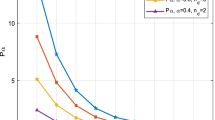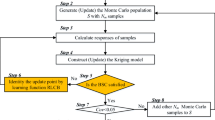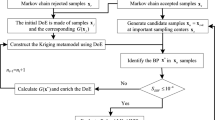Abstract
In the reliability analysis of engineering structures, there are usually implict and highly nonlinear performance function problems, which leads to the time-consuming computations. In this paper, a novel Kriging based reliability analysis method combined with the improved efficient global optimization (IEGO) and a secondary point selection strategy is proposed. Based on the IEGO algorithm, the expected improvement function is redefining, which will focus on the points both with large variance and near the limit state surface. Moreover, a secondary point selection strategy is raised to find the point with larger expected improvement and closed to the limit state surface, which can further improve the efficiency of the active learning process. Five examples indicates that the raised method has satisfactory global and local search capability, and can evaluate the probability of failure efficiently.
Similar content being viewed by others
References
Y. T. Wu, Computational methods for efficient structural reliability and reliability sensitivity analysis, AIAA Journal, 32 (8) (1994) 1717–1723.
S. K. Au, Reliability-based design sensitivity by efficient simulation, Computers & Structures, 83 (14) (2005) 1048–1061.
C. Tong, Z. L. Sun and Q. L. Zhao, A hybrid algorithm for reliability analysis combining Kriging and subset simulation importance sampling, Journal of Mechanical Science and Technology, 29 (8) (2015) 3183–3193.
B. Echard et al., A combined importance sampling and Kriging reliability method for small failure probabilities with timedemanding numerical models, Reliability Engineering and System Safety, 111 (8) (2013) 232–240.
G. I. Schuller, H. J. Pradlwarter and P. S. Koutsourelakis, A critical appraisal of reliability estimation procedures for high dimensions, Probabilistic Engineering Mechanics, 19 (4) (2004) 463–473.
J. Morio et al., A survey of rare event simulation methods for static input-output models, Simulation Modelling Practice and Theory, 49 (2014) 287–304.
R. Rackwitz and B. Fiessler, Structural reliability under combined random load sequences, Computers & Structures, 9 (5) (1978) 489–494.
F. F. Xiong et al., A double weighted stochastic response surface method for reliability analysis, Journal of Mechanical Science and Technology, 26 (8) (2012) 2573–2580.
D. Q. Zhang et al., Time-dependent reliability analysis through response surface method, Journal of Mechanical Design, 139 (4) (2017) 041404.
D. L. Allaix and V. I. Carbone. An improvement of the response surface method, Structural Safety, 33 (2) (2011) 165–172.
H. Z. Dai et al., Structural reliability assessment by local approximation of limit state functions using adaptive markov chain simulation and support vector regression, Computer- Aided Civil and Infrastructure Engineering, 27 (9) (2012) 676–686.
J. M. Bourinet, F. Deheeger and M. Lemaire, Assessing small failure probabilities by combined subset simulation and support vector machines, Structural Safety, 33 (6) (2011) 343–353.
H. Z. Dai, H. Zhang and W. Wang, A support vector densitybased importance sampling for reliability assessment, Reliability Engineering & System Safety, 106 (2012) 86–93.
J. Cheng et al., A new approach for solving inverse reliability problems with implicit response functions, Engineering Structures, 29 (1) (2007) 71–79.
V. Papadopoulos et al., Accelerated subset simulation with neural networks for reliability analysis, Computer Methods in Applied Mechanics and Engineering, 223–224 (2012) 70–80.
G. B. Kingston et al., Computational intelligence methods for the efficient reliability analysis of complex flood defence structures, Structural Safety, 33 (1) (2011) 64–73.
S. Choi, G. Lee and I. Lee, Adaptive single-loop reliabilitybased design optimization and post optimization using constraint boundary sampling, Journal of Mechanical Science and Technology, 32 (7) (2018) 3249–3262.
S. Lee and J. H. Kim, An adaptive importance sampling method with a Kriging metamodel to calculate failure probability, Journal of Mechanical Science and Technology, 31 (12) (2017) 5769–5778.
B. Echard, N. Gayton and M. Lemaire, AK-MCS: An active learning reliability method combining Kriging and Monte Carlo simulation, Structural Safety, 33 (2) (2011) 145–154.
G. Matheron, The intrinsic random functions and their applications, Advances in Applied Probability, 5 (3) (1973) 439–468.
Z. Liu et al., Hybrid structure reliability method combining optimized Kriging model and importance sampling, Acta Aeronautica et Astronautica Sinica, 34 (6) (2013) 1347–1355.
J. Wei, J. G. Zhang and T. Qiu, Structural reliability algorithm based on improved dynamic Kriging model, Journal of Beijing University of Aeronautics and Astronautics, 45 (2) (2019) 373–380.
D. R. Jones, M. Schonlau and W. J. Welch, Efficient global optimization of expensive black-Box functions, Journal of Global Optimization, 13 (4) (1998) 455–492.
B. J. Bichon et al., Efficient global reliability analysis for nonlinear implicit performance functions, AIAA Journal, 46 (10) (2008) 2459–2468.
Z. Y. Lv, Z. Z. Lu and P. Wang, A new learning function for Kriging and its application to solve reliability problems in engineering, Computers & Mathematics with Applications, 70 (5) (2015) 1182–1197.
M. Balesdent, J. Morio and J. Marzat, Kriging-based adaptive importance sampling algorithms for rare event estimation, Structural Safety, 44 (2334) (2013) 1–10.
X. X. Huang, J. Q. Chen and H. P. Zhu, Assessing small failure probabilities by AK-SS: An active learning method combining Kriging and Subset simulation, Structural Safety, 59 (2016) 86–95.
I. Depina et al., Reliability analysis with metamodel line sampling, Structural Safety, 60 (2016) 1–15.
W. Y. Yun, Z. Z. Lu and X. Jiang, An efficient reliability analysis method combing adaptive Kriging and modified importance sampling for small failure probability, Structural and Multidisciplinary Optimization, 58 (2018) 1383–1393.
J. Sacks, S. B. Schiller and W. J. Welch, Design for computer experiment, Technometrics, 31 (1) (1989) 41–47.
H. L. Zhao et al., An efficient reliability method combining adaptive importance sampling and Kriging metamodel, Applied Mathematical Modelling, 39 (7) (2015) 1853–1866.
X. K. Yuan et al., A novel adaptive importance sampling algorithm based on Markov chain and low-discrepancy sequence, Aerospace Science and Technology, 29 (1) (2013) 253–261.
Z. L. Sun et al., LIF: A new Kriging based learning function and its application to structural reliability analysis, Reliability Engineering & System Safety, 157 (2017) 152–165.
F. Cadini, F. Santos and E. Zio, An improved adaptive Kriging-based importance technique for sampling multiple failure regions of low probability, Reliability Engineering & System Safety, 131 (8) (2014) 109–117.
B. Keshtegar and Z. Meng, A hybrid relaxed first-order reliability method for efficient structural reliability analysis, Structural Safety, 66 (2017) 84–93.
P. Wang, Z. Z. Lu and Z. C. Tang, An application of the Kriging method in global sensitivity analysis with parameter uncertainty, Applied Mathematical Modelling, 37 (9) (2013) 6543–6555.
W. Y. Yun et al., A novel step-wise AK-MCS method for efficient estimation of fuzzy failure probability under probability inputs and fuzzy state assumption, Engineering Structures, 183 (2019) 340–350.
P. J. Zheng et al., A new active learning method based on the learning function U of the AK-MCS reliability analysis method, Engineering Structures, 148 (2017) 185–194.
Acknowledgments
The financial supports from the National Science and Technology Major Project of China (Grant No. 2017-V-0013-0065 and Grant No.2017-V-0010-0060) are gratefully acknowledged.
Author information
Authors and Affiliations
Corresponding author
Additional information
Recommended by Editor Chongdu Cho
Hong Linxiong is a Ph.D. candidate in the School of Power and Energy, Northwestern Polytechnical University. His research interests include structural reliability, aero-engine fuel system and others.
Rights and permissions
About this article
Cite this article
Linxiong, H., Huacong, L., Kai, P. et al. A novel kriging based active learning method for structural reliability analysis. J Mech Sci Technol 34, 1545–1556 (2020). https://doi.org/10.1007/s12206-020-0317-y
Received:
Revised:
Accepted:
Published:
Issue Date:
DOI: https://doi.org/10.1007/s12206-020-0317-y




